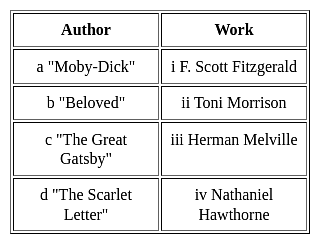TS SET Paper 2 Mock Test - 2 (English) - TS TET MCQ
30 Questions MCQ Test TS SET Mock Test Series 2024 - TS SET Paper 2 Mock Test - 2 (English)
Given below are two statements one is labelled as Assertion and the other one is labelled as reason.
Assertion: New Historicism seeks to explore the interconnections between literature and historical context, rejecting the idea of an isolated literary text.
Reason: Practitioners of New Historicism argue that literary works are shaped by and shape the cultural and historical circumstances in which they are produced
The play was written in 1881 when its author was in Italy. This is considered to be his most remarkable intellectual effort. The softening of the brain as a result of a disease inherited from his father is the subject. Which is the play?
| 1 Crore+ students have signed up on EduRev. Have you? Download the App |
Which period in the history of the English language was characterized by the significant influence of the Norman Conquest of 1066?
Choices of linguistic forms in using a language, or how a language is actually spoken/written, especially one that differs from its prescription grammar, is called
In which novel does Fyodor Dostoevsky explore the themes of faith, doubt, and the search for meaning in life through the story of a group of intellectuals and their interactions with a mysterious stranger?
Who among the following are major writers belonging to the confessional poetry movement of the 1960s?
(i) Sylvia Plath
(ii) Robert Lowell
(iii) Anne Sexton
(iv) W. H. Auden
The right combination according to the code is:
Robert Browning’s “Rabbi Ben Ezra” is a defence of
“Fair is my love, and cruel as she’s fair; Her brow-shades frown, although her eyes are sunny”. The above lines are characterized by:
The author of the Archetypal Patterns in Poetry is
In which novel does Margaret Atwood explore the themes of environmental degradation, climate change, and the interconnectedness of all living beings?
Match the characters with the plays in which they feature:

Who among the following proposed that the First Gulf War had never taken place, it was simply a hyperreal, media-generated spectacle?
Which of the following are the works of Margaret Atwood?
a) The Handmaid's Tale
b) Surfacing
c) White Noise
d) The Sellout
Combine the statements correctly : According to Homi Bhabha _____ .
- mimicry is not mere copying or emulating the colonizer's culture, behavior and manners.
- but it is further aimed at perfection and excess.
- mimicry is mere copying the colonizer's culture behavior and manners____
- but is informed by both mockery and a certain menace.
Which of the following is an incorrect assumption in language teaching?
|
60 tests
|


















